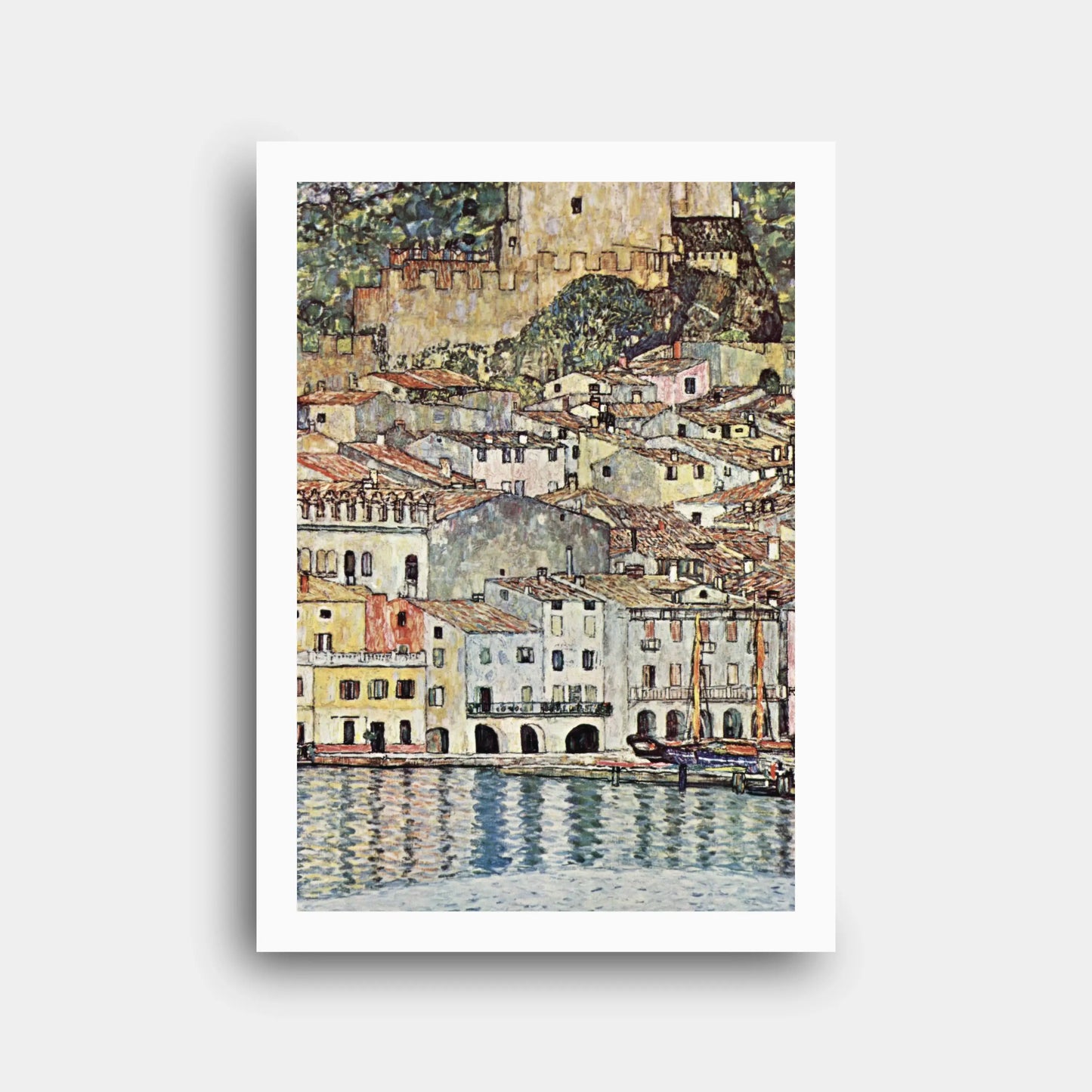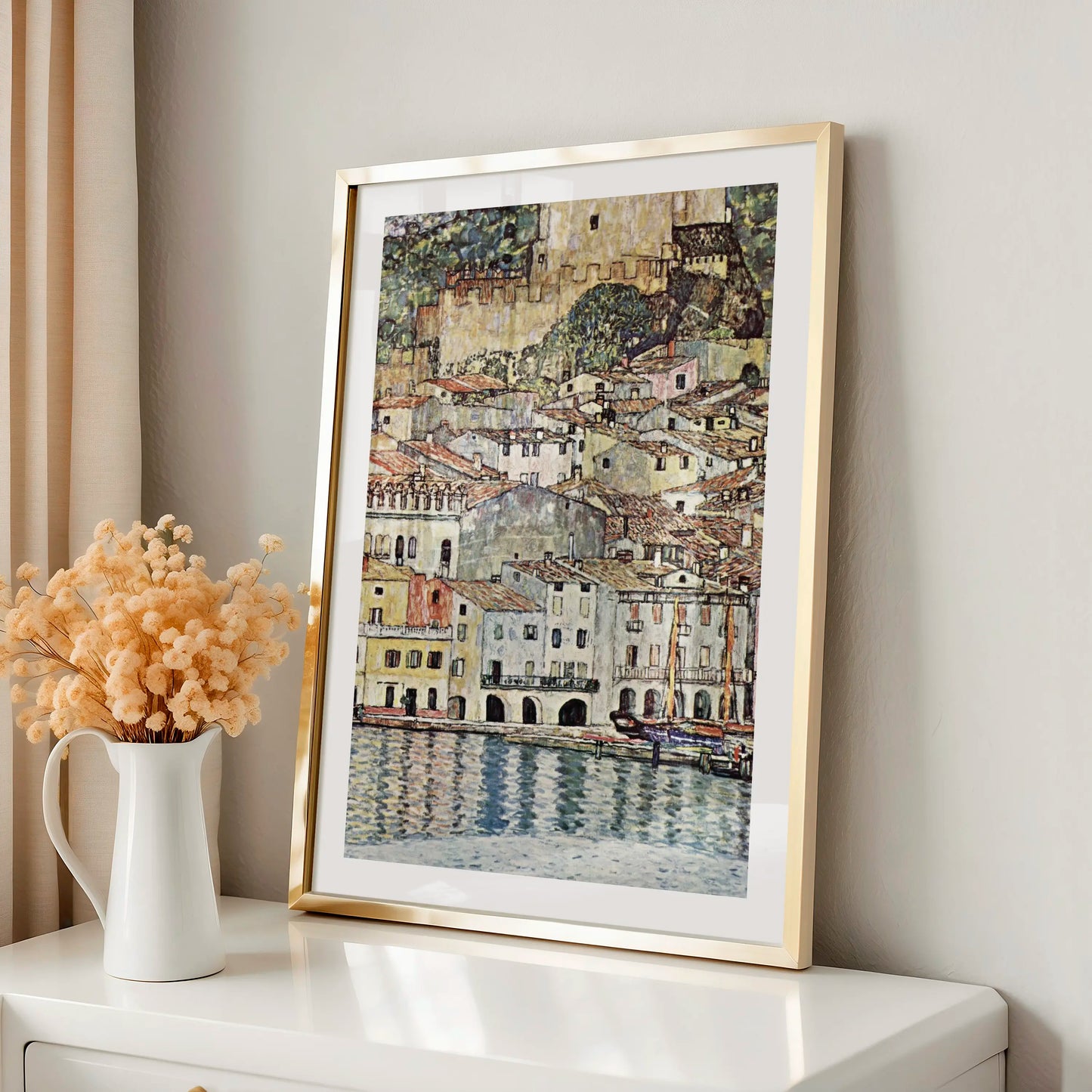Gustav Klimt - Malcesine am Gardasee (1913) - Paper Poster N183
Gustav Klimt - Malcesine am Gardasee (1913) - Paper Poster N183
Couldn't load pickup availability
Share
Paper Poster | Canvas Print | Digital File
1. Historical and Artistic Context
Gustav Klimt painted “Malcesine am Gardasee” in 1913 during his only extended stay in Italy, specifically at Lake Garda. Until then, most of his landscape works were created at Lake Attersee in Austria. The Italian trip brought a new vibrancy and luminosity to his palette, influenced by the Mediterranean light and architecture. Malcesine, a small lakeside town with medieval fortifications and colorful houses, provided Klimt with the perfect subject to experiment with flattened perspectives and rhythmic patterns. The work reflects Klimt’s late period, when his landscapes became equally as important as his portraits and allegories.
2. Technical and Stylistic Analysis
The painting presents a tightly packed composition of cube-like houses rising from the shore up to the medieval castle. Instead of using linear perspective, Klimt flattens the scene into overlapping blocks of color. The roofs, walls, and reflections in the water form a tapestry-like effect, reminiscent of mosaic patterns. His brushwork emphasizes contour lines, turning architectural details into decorative motifs. This stylistic choice aligns with Klimt’s broader artistic language, where ornament and rhythm replace strict realism. The nearly square format reinforces the balance and decorative quality of the work.
3. Symbolism and Interpretation
Though it may appear as a straightforward townscape, the painting conveys deeper meanings. The interlocking houses suggest unity and harmony between human creation and nature. The reflections in the water symbolize both permanence and transience, capturing the fleeting shimmer of light. The medieval castle towering above the village may represent history and endurance, while the colorful houses embody daily life and vitality. Klimt transforms Malcesine into more than a place: it becomes a metaphor for continuity, memory, and the coexistence of culture and landscape.
4. Technique and Materials
Klimt worked on a square-format canvas, a format he favored for its stability and decorative resonance. The medium was oil on canvas, applied in layered strokes to build color intensity. Klimt often painted landscapes outdoors with the help of binoculars for distant views, later refining them in the studio. His palette here is dominated by earthy reds, yellows, and soft grays for the houses, contrasted with greens from surrounding vegetation and shimmering blues in the water. This combination results in a surface that vibrates with chromatic harmony.
5. Cultural Impact
“Malcesine am Gardasee” became an emblem of Klimt’s brief but meaningful Italian experience. It showed how his decorative style could capture not only allegorical or symbolic scenes but also everyday urban landscapes. By incorporating elements reminiscent of Cubism and Impressionism, the work bridged Viennese Secession aesthetics with broader European modernism. The painting also influenced how later generations perceived Klimt: not only as a portraitist of women in gold but also as a master of landscape abstraction. It remains a significant cultural link between Austria and Italy in early twentieth-century art.
6. Critical Reception and Scholarly Interpretations
Art historians have praised the painting for its unusual stillness, almost immobile composition, and for the way it abstracts the city into decorative units. Some interpret it as Klimt’s response to Cubism, flattening architecture into pure design. Others see it as part of his exploration of harmony between man-made and natural structures. Critics highlight the joyous colorism and the contrast with his darker, more claustrophobic Viennese interiors. Overall, it has been regarded as one of his most accomplished landscape works, even though it is less well known than his portraits.
7. Museum, Provenance and Exhibition History
The original painting is unfortunately lost. Initially, it belonged to Viktor Zuckerkandl, one of Klimt’s close patrons, before entering the Lederer family collection in Vienna. During the Nazi era, the painting was confiscated by the Gestapo in 1938, along with many other Klimt works. Unlike some pieces destroyed in the fire at Schloss Immendorf, its whereabouts after World War II remain unknown. Before its loss, it was exhibited in major European cities, including Vienna, Paris, and Bern. Today, it is known only from reproductions and archival photographs.
8. Interesting Facts
1. Klimt painted “Malcesine am Gardasee” during his only summer at Lake Garda.
2. He was accompanied on the trip by Emilie Flöge, his lifelong companion.
3. The painting belongs to a trio of Garda landscapes, along with “Italian Garden Landscape” and “Church in Cassone.”
4. Klimt painted landscapes in square formats to emphasize decorative balance.
5. He often used binoculars to study distant views while painting outdoors.
6. The painting reflects hints of Cubism, though Klimt never fully embraced the style.
7. It was once part of the Lederer family’s famed Klimt collection.
8. The Nazis confiscated it in 1938, and it has been missing since.
9. Surviving reproductions come from exhibition catalogs and archives.
10. Scholars often describe it as one of Klimt’s most abstract and modern landscapes.
9. Conclusion
“Malcesine am Gardasee” stands as a remarkable example of Gustav Klimt’s late landscape style, blending decorative rhythm, vivid color, and symbolic resonance. Although the original is lost, its reproductions reveal a work that embodies both the timeless charm of an Italian town and the modernist spirit of early twentieth-century art. By transforming architecture into patterns of color and form, Klimt captured not just a place, but a mood and a vision of harmony between man, history, and nature. The painting remains a testament to his ability to merge ornament and observation into a singular artistic language.











